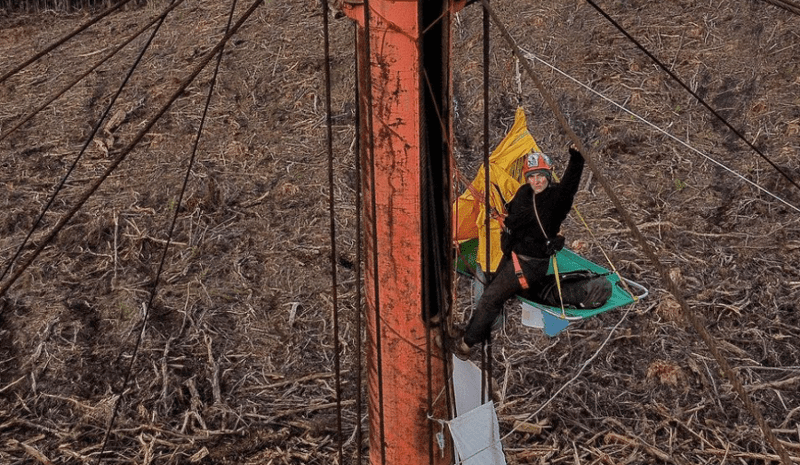Yosemite Climber Turns to Saving Old Trees
John Middendorf and his DIY Ledge for environmental activists and climbers

Climber and noted author Paul Pritchard has climbed with John Middendorf for decades and they’re still at it, although now, mostly as part of the movement to preserve the old-growth Tarkine forests in their home in Tasmania. “Deucey is committed to saving the remaining stands of old growth forest on this island at the end of the world,” said Pritchard. “He has produced scores of portaledges which activists use in nonviolent direct-action protests to protect these tallest flowering plants on earth and climbs a rope like a slug up a downspout.”
John Middendorf, one of the most active and creative American big wall climbers of the 1980s, did several new routes in Yosemite, including El Capitan’s The Atlantic Ocean Wall VI, 5.10 A5 and expanded his exploits to Colorado’s Black Canyon of the Gunnison and Zion in Utah and the sandstone pinnacles of the southwest. In 1992, he brought his big wall skills to the first ascent of The Grand Voyage, Great Trango Tower in the Pakistan Karakoram with Swiss climber Xaver Bongard, an 18-day adventure on the 1,340 m wall.
Middendorf started climbing on the East Coast, and after graduating with honours in mechanical engineering at Stanford, was lured from the straight and narrow to Yosemite, where he spent close to three years on the forefront of the climbing scene and working on the rescue team. After a move to Arizona, he added bridge jumping, environmental activism, and founding A5 Designs to provide specialized gear like hammers, haul bags and soft goods suitable for big walling to his resume. Middendorf sold the concern to The North Face in 1997. Now he lives in Tasmania, Australia, a country he had fallen in love with on climbing trips, with his partner and children. A teacher, tinkerer and a climbing historian, whose books on climbing technology are must-reads, he has also tried to democratize portaledge making, partly as an extension of his environmentalism.
In 2019, Middendorf shared the pattern for his D4 portaledges with other companies, and in 2020, when COVID hit, he says, “I decided to throw it all to the public winds, and have helped a number of makers with their own small batches of production portaledges. I can name five or six who were selling them commercially, but there are many more homebuilders.”

The decision was closely tied to his involvement with the active campaign for the preservation of the Tarkine rainforest in Tasmania, an 1,800 km² rare temperate rainforest, “In the many wild places of the world I have experienced,” said Middendorf, “the intensity of the wave of grandeur amidst Takayna’s giant trees matched that of times such as my first visit to the California redwoods, or the first sight of massive foothills of the Karakoram—nature on another scale of beauty and awe.”
Middendorf developed the DIY Activist Ledge specifically with non-violent activist demonstrations in mind. Activists occupy the giant trees of the forest with sits, or portaledges, as climbers call them, to prevent loggers from cutting them down. Before Middendorf, activist ledges, as described by Tarkine activist Erik Hayward, could use improvement: “a bed frame, plywood and bush pole for ridge pole to hang a cheap tarp over during the rain…thirty kilograms of awkward bulk that’s like a sail in the wind.” Middendorf’s light, portable ledge can be made with locally sourced materials for about $100 USD, so it’s accessible and relatively affordable by protesters. It’s possible, said Middendorf, “to make even cheaper–the frame is the most expensive part that has to be bought. We are making beds our of old sails and using other recycled materials for some prototypes.”
Middendorf saw an application for an inexpensive portaledge. “I am devolving my ledge design to be less expensive,” said Middendorf, “and use more readily available materials and modifying the design so there is minimal waste without compromising on the strength and weatherproof-ness of these sits, as the weather can be fierce here….Volunteer activists have been DIYing and producing lots of sits at Australian conservation group, the Bob Brown Foundation, and we need to make them fast and effectively as they often get confiscated or destroyed by angry contractors during NVDA (non-violent direct action) blockades.”
Middendorf, while giving primacy to the importance of being aware of the environmental perils of deforestation and getting involved in environmental activism in general, says climbers might want to get involved in forest activism because their skills are useful, although he also says they have “a lot to learn about safe tree climbing techniques.”
Climbers, said Middendorf, may also be drawn to “the quest for the easy-to-make, $100 DIY portaledge with minimal waste and “ease-of-build so activists who need safe weatherproof aerial tents can build them on their own with minimal instruction. We build these for trees, though they might also be suitable for big walls with a little more abrasion reinforcement.”
As for future developments, Middendorf is ready to hand on the work of technological innovations to others. “I don’t have a ‘business’, just a shed to tinker in,” said Middendorf. “My main advice I give to budding inventors whose ideas are mainstreamed by larger industry players, just keep out-innovating the bastards!” See how you can make your own Middendorf ledge here.


